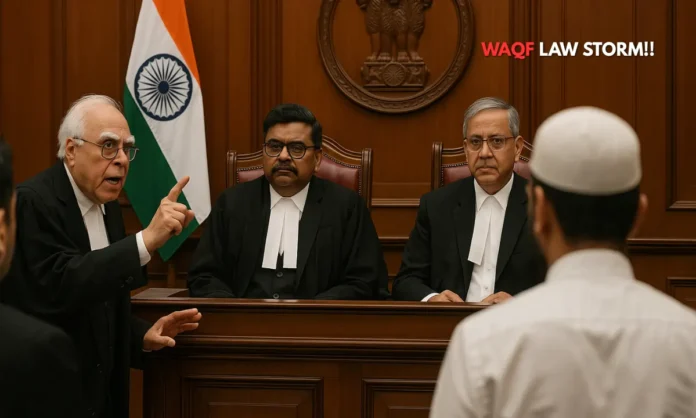Summary
• Supreme Court questions legality of new Waqf law, but stresses high threshold for interference.
• Petitioners argue the amended Act infringes on Articles 14, 25, and 26, facilitating property takeover.
• Concerns raised about waqf-by-user clauses, religious verification, and minority rights.
India’s Sacred Lands and Legal Lines: The Waqf Debate Reignited
In a nation where spiritual legacies are deeply woven into the socio-political fabric, the Supreme Court has stepped into the storm over the controversial Waqf (Amendment) Act, 2025. This legislative change has sparked a constitutional and cultural debate, with implications for minority rights, property law, and the limits of state power.
On Wednesday, a bench led by Chief Justice of India B R Gavai and Justice Augustine George Masih heard a cluster of petitions challenging the constitutional validity of the new Waqf law. Representing the petitioners, Senior Advocate Kapil Sibal launched a sharp critique, describing the law as a legislative weapon to seize private property under the guise of religious endowment protection.
The courtroom exchange echoed broader anxieties over the balance between religious freedoms and state control. As CJI Gavai noted, the judiciary maintains a strong presumption in favour of a statute’s constitutionality. Petitioners, therefore, bear the burden of demonstrating clear and compelling grounds for judicial intervention.
NO INTERIM STAY ON WAQF ACT!
— Sunny Raj (@SunnyRajBJP) May 20, 2025
Supreme Court Says: Courts rarely step into constitutional laws. Strong grounds needed to challenge the act. Till then, the ACT IS PRESUMED VALID.
pic.twitter.com/A3R1l9ZhKU
The New Law’s Fault Lines: Ownership, Identity, and Encroachment
- Petitioners argue the Act violates Articles 14 (equality), 25 (freedom of religion), and 26 (rights of religious denominations).
- The Act introduces clauses allowing waqf-by-user, waqf-by-deed, and state power to denotify court-protected properties.
- Petitioners question the requirement of proving one’s religious practice to assert property rights.
At the heart of the legal challenge is the claim that the new Act fundamentally changes the character of waqf governance. Sibal contended that while the law is framed as protective, it is in effect a mechanism to consolidate state control over individual and community-owned assets. “The idea of waqf is that it’s my property, donated for a cause. This law takes it away through a legislative diktat,” he argued.
He further raised concerns over identity verification requirements, such as the need to prove that one is a practising Muslim to contest a waqf designation—a stipulation he deemed intrusive and unconstitutional.
The Bench Responds: Legal Limits and Lived Realities
- Chief Justice Gavai emphasized judicial restraint, stating courts typically do not interfere with legislative wisdom.
- The court acknowledged disputes in regions like Aurangabad as symptomatic of deeper waqf management issues.
- Interim orders are being considered on three fronts: waqf-by-user, waqf-by-deed, and denotification powers.
In response to Sibal’s pointed arguments, the CJI remained cautious. While acknowledging the contentious nature of waqf disputes, he reiterated that any intervention into legislative matters demands a strong, unequivocal case.
Notably, during an earlier hearing, the bench also took stock of provisions that could impact minority cultural heritage, including the treatment of protected monuments under the amended framework. Sibal warned that previously safeguarded historical sites may now fall vulnerable to encroachment, diminishing protections for religious minorities.
Contours of a Verdict: Between Property Rights and Communal Sensitivities
As the hearings proceed, the Waqf Amendment case has come to embody a larger question: Can a secular state redefine religious endowment laws without eroding the freedoms enshrined in its constitution?
The answer will not only affect the fate of waqf properties but also serve as a litmus test for how India negotiates the intersection of law, identity, and legacy.


